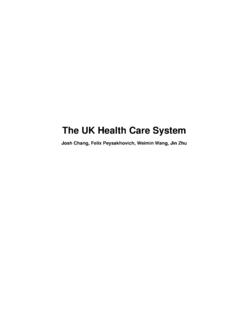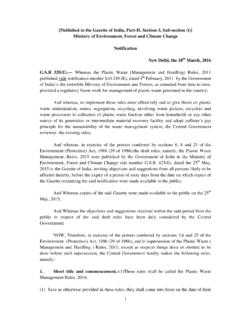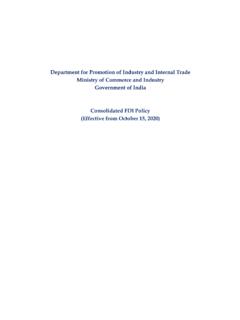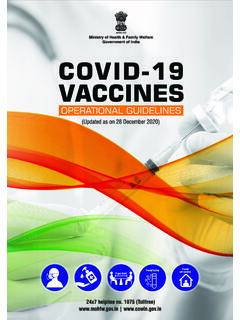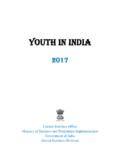Transcription of Healthcare in India - Columbia University
1 Healthcare in India Overview The opportunity to enter India s Healthcare industry is very attractive. The estimated of GDP generated from the Healthcare market to reach over billion denizens is underdeveloped and seems like a great opportunity for However, before rushing into this prospect, there must be an examination of the intricate facets of the current Healthcare market in India . The existing contrast in the availability of India s Healthcare seems as large as its population. When it comes to Healthcare , the estimated 1,205,073,612 Indians are split into two groups. The middle and upper classes, which generally live in the urban areas of India , have access to quality medical care. However, the majority of India lives below the poverty line in rural areas and has extremely limited access to medical care.
2 Most rely on homeopathic or cultural remedies. The stark inequality of available Healthcare has shaped the current market environment and should always be kept in mind when exploring the industry. Besides the lack of overall Healthcare infrastructure, the second most important influence on India s Healthcare industry is its lack of a medically insured population and high out-of-pocket expenditure ( ).2 India s insurance industry has fluctuated between public and private ownership for most of the 20th century. The Insurance Amendment Act of 1950 ultimately led to the government of India deciding to nationalize the insurance business. However, in August of 2000, The Insurance Regulatory and Development Act (IRDA) opened up the market with the invitation for registration applications.
3 Today, the major insurance companies in India are: New India ( market share), United India ( ), National ( ), ICICI Lombard ( ) and Oriental ( ) 1 Total health expenditure as percentage of 2009 estimate from World Health Organization 2 2005 report from World Health Organization Article: National Health Accounts in India with ICICI Lombard being the only private company of the However, these public and private insurance options only cover a small minority of the The rest of India is subject to self-funding medical expenses not covered by the government s universal Healthcare (See footnote for coverage details and figure 2 for expenditure breakdown). 5 While the insurance industry is limited in the number of people it reaches, it does make up some ground in terms of sophistication.
4 There is a public reinsurer, general insurance company (GIC), which is the sole reinsurance company of India . There are also over 12,000 registered actuaries with the Institute of Actuaries of India who are involved in the pricing, reserving and other analytical roles in health insurance Through the Actuaries Act of 2006, these professionals are governed by a myriad of regulations mandated by a collection of councils, committees and advisory groups. Major Health Concerns The World Health Organization s 2000 global Healthcare profile ranked India s Healthcare system 112th out of 190 countries. This survey highlighted four major health concerns for India that still are prominent today. The first concern is the high vulnerability of young children.
5 Among children under five, are underweight (the highest percentage in the world) and have die before their fifth birthday (which is quite high compared to United States rate of ).7 The second major concern is poor sanitation. Only about 30% of the population uses improved sanitation facilities and this figure dips below 20% when focusing solely on the rural 3 Based upon 2010-2011 IRDA data 4 2005 article from ministry of health and family welfare government of India Financing and Delivery of Health Care Services in India 5 National Health Policy 1983 was aimed to achieve the goal of `Health for All' through: creation of an infrastructure for primary Healthcare ; improved nutrition, drinking water supply, sanitation, the provision of essential drugs and vaccines.
6 The policy was updated in 2002 to include reduced insurance premiums for citizens below poverty line. 6 For more information on Actuaries in India , refer to 7 Pulled from 2009 World Health Organization Health Profile 8 ID The final concern is disease. The top three are malaria, tuberculosis, and diarrhea. 9 Combined, these health concerns have hindered India s life expectancy: 63 for males and 66 for females, which is considerably lower than the United States life expectancy of 69 and 75 respectively. 10 Social Health Initiatives It is both challenging and expensive to try to attain the goal of universal health coverage in a country where most of its people are unemployed or employed informally. From 1948 to now, the Indian government has launched a series of social health insurance schemes to ensure Healthcare access to the middle and upper classes as well as the poor and other special populations.
7 The following table is a summary of the schemes launched. Name of Scheme Year of Enactment Target Objective Means of Financing ESIS: Employee s State Insurance Scheme11 1948 Employees with income less than Rs 15000/month and dependents To achieve universal health coverage Financed by state government , employers and employees CGHS: Central government Health Scheme 1954 government employees and families To achieve universal health coverage Financed by state government , employers and employees ICDS: Integrated Child Development Services12 1975 Malnutrition children under age 6 To improve nutrition and health status to children The government , the United Nations Children's Fund (UNICEF) and the World Bank RSBY: Rashtriya Swasthya Bima Yojana13 2009 The poor below the poverty line To provide affordable Healthcare to the poor Financed by Federal (75%) and State (25%) government NPHCE: National Programme for the Health Care of the Elderly 14 2011 Seniors To provide the elderly an easy access to primary Healthcare ministry of Health & Family Welfare 9 For detailed statistics on disease refer to 10 Pulled from 2009 World Health Organization Health Profile 11 Reference from 12 Reference from 13 Reference from 14 Pulled from the national program for the health care of the elderly operational guidelines Public and Private Health Insurance Health insurance is really a minor player in the health ecosystem.
8 The very candid statement from the Report of the National Commission on Macroeconomics and Health of India (2005) goes on to say that only 3% to 5% of Indians are covered by health insurance In the barely developed health insurance market, the Indian government plays an important role by launching social health insurance schemes and regulating private health insurance companies. The major public health insurers in India are the government -run General Insurance Corporation (GIC) and its four former subsidiaries: New India Assurance Company, United India Insurance Company, National Insurance Company, and Oriental Insurance Company. GIC was converted into a reinsurer in year 2000. The main health insurance product sold in India is the GIC Mediclaim policy which was originally offered in 1986.
9 This indemnity plan is designed so that the insured is responsible to pay out-of-pocket expenses to the doctors and then files a claim to get reimbursed. This costly reimbursement policy favors a wealthier clientele. As a result, most Mediclaim policy holders are from the middle and upper class. In contrast, the poor are not able to afford the premium and pay the medical fees up front (The premiums are roughly 30 US dollars a month for policy holder and one dependent).16 Over time, Mediclaim has become a colloquial term to refer to all similar policies sold by different private insurance companies in India . Today s typical Mediclaim policy has a general coverage in which reimbursements of hospitalization expenses are paid for the following: a.
10 Room and board expenses provided by hospitals, nursing homes, Nursing expenses b.) Specialist Fees from a surgeon, anesthetist, medical practitioner or consultant c.) Medical treatment, diagnostic material, X-rays, dialysis, chemotherapy, radiotherapy, pacemakers, artificial limbs, and transplants17 15 2005 article from ministry of health and family welfare government of India Financing and Delivery of Health Care Services in India . However, today, the percentage of India that is insured is closer to 15% according to a 2011 New York Times article. 16 Based upon figure from New India s Premium Mediclaim chart converting Rupees to dollars at a rate of to 1. 17 List of Healthcare coverage pulled from Regulation After the Insurance Regulatory and Development Authority Act was passed in 1999, a governing body under the same name (IRDA) was set up to regulate insurers and protect the insured s IRDA s objectives include setting and enforcing standards, ensuring speedy settlement, preventing claim frauds and building information systems.


